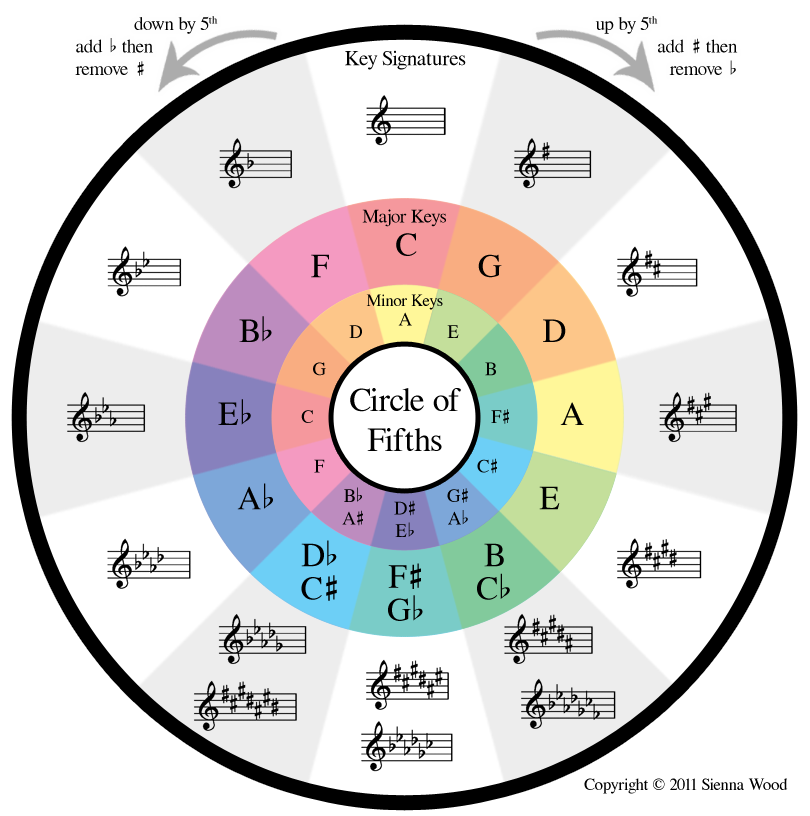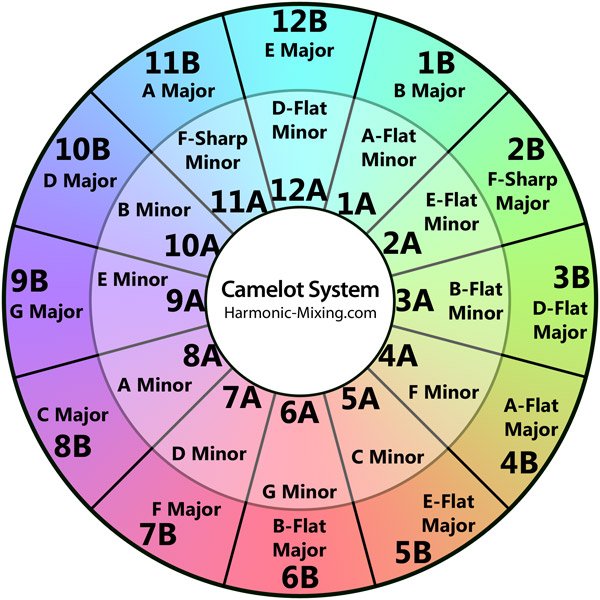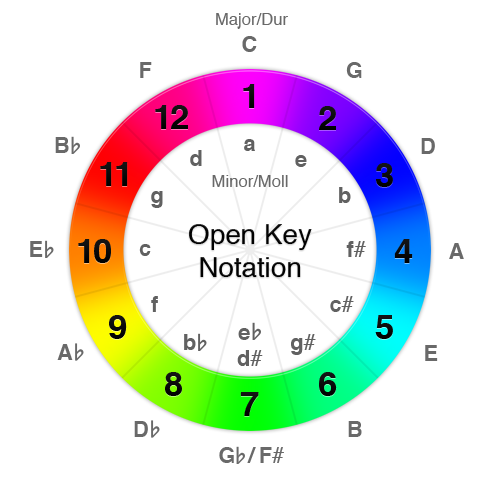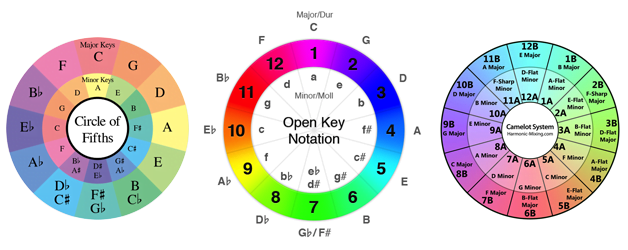I've briefly talked about harmonic mixing in previous posts and figured this would be a good time to go into detail. I'll cover apps for detecting and organizing by key, notation systems they use, and then the techniques I use.
The Circle of Fifths
All songs have a key, which is a dominant note from which other notes & chords will match and sound best. Major keys are most common and have a pleasant upbeat feel while minor keys feel slightly down or bittersweet. There's many types of keys but most electronic dance music use major & minor keys.
What's fascinating about major & minor keys is that they follow a predictable harmonic pattern. Depending on which note you start with, there's a progression that will naturally follow. So if you're playing a song in C major, you can follow it with a song in G major and they'll harmonize nicely.
The map for these keys is the Circle of Fifths:

Key Notation Systems
Keeping track of the keys and notes around the circle may be easy for musicians, but for DJs it's hard to remember. A couple of apps have simplified the layout notation to make it much easier: instead of notes, they see the circle as a 12-hour clock and match major & minor notes to positions on the clock.
Mixed in Key is probably the most popular app and uses a proprietary system called Camelot Notation:

Keys are denoted by numbers and A/B for minor/major keys respectively, so E major is 12B and D-flat minor is 12A. You'll notice C isn't up top at 12 (it's down at bottom left at 8). This rotation and the A/B codes are the core of Mixed in Key's copyrighted system.
Traktor just recently added key detection and organization. Even though Mixed in Key is heavily used by DJs, Traktor chose to use an open-source system called Open Key Notation:

Open Key's notes closely match the original circle of fifths, except 1 o'clock is on top instead of 12. Open key uses D / M for major / minor, based on German (dur / moll) rather than English (major / minor). So F major is 12d and D minor is 12m.
My Notation (aka Circle of Fifths)
The only problem with the two existing systems is they don't naturally match a clock nor each other. Between them C major is 8B and 1m while A minor is 8A and 1d. That's pretty wonky, especially considering the long legacy of the Circle of Fifths. At the very least C major should either be 12B or 12d, but neither system does it. If C isn't 12, then it doesn't really matter what code is used for major/minor - they fundamentally did it wrong.
As such, I'll be using my own notation system in this post. I'll just call it Circle of Fifths Notation because that's all it is. This format sticks to the classic circle with C at 12 o'clock and simply uses capitalization for Major vs. minor. So C major is 12M and A minor is 12m.
I prefer this form of notation because it matches hundreds of years of music notation, which in turn makes it easily readable by musicians, and it's easy to look up on any natural Circle of Fifths chart. In fact, I'll be introducing this notation later this year in my music app, Cloudskipper.
How to Use Key Notation
So how does it work? It's a numbers game! Just follow the numbers and you'll mix in harmony effortlessly.
At the simplest level you find another track that has the same number as what's currently playing and mix it in - they'll match because they're in the same key. So 12M goes into 12M, 1M goes into 1M, and so on.
A better way for me to say "goes into" is to use arrows: 12M --> 12M, 1M --> 1M.
You can also move up and down one number around the clock. You'll change keys but you'll still stay in harmony. So 12M --> 1M, but also 1M --> 12M, so really 12M <--> 1M. Two arrows mean goes both way.
Also, anything a major key can do, a minor key can. So 12m <--> 1m works just as well as 12M <--> 1M. But major and minors are not very interchangeable: you can't mix 12M --> 1m. That would sound horrible! The only easy way to switch from major to minor and back is to stick with the the same key: 12M <--> 12m or 1M <--> 1m.
Here's a list of ways to match keys.
Same Key
- 12A <--> 12A (Camelot)
- 12m <--> 12m (Open Key)
- 12m <--> 12m (Circle of Fifths)
Two songs with the same number will harmonize. You're essentially staying in the same key so only the melody will change. This is essentially "no harmonic" transition, which is fine, but it can sound really boring if you stay in the same key for too long. It's ok to use, just remember to change key after three.
Up or Down a Fifth
- 12A <--> 1A (Camelot)
- 12m <--> 1m (Open Key)
- 12m <--> 1m (Circle of Fifths)
You can also move up and down the numbers a step at a time, so 12M will mix naturally with 11M and 1M. This is the most common form of harmonic mixing.
Major / Minor Swap
- 12A <--> 12B (Camelot)
- 12m <--> 12d (Open Key)
- 12m <--> 12M (Circle of Fifths)
Mixing between major and minor keys can clash, but you can naturally mix between them if they're the same number.
Energy / Modulation Mix
- 12A --> 7A (Camelot)
- 12m --> 7m (Open Key)
- 12m --> 7m (Circle of Fifths)
You will cause a noticeable energy change by moving up or down by 7 numbers. Moving up 7 will cause a boost, but moving down 7 will actually drain energy (even though it's really a chromatic step).
Double-Energy Mix
- 12A --> 2A (Camelot)
- 12m --> 2m (Open Key)
- 12m --> 2m (Circle of Fifths)
Double-energy mix is energy mix doubled, so instead of 7 you go for 14. Since the clock is only 12 units, that really means you go up or down by 2. The +2 energy boost is huge but a -2 energy drain could very well clear the floor.
Step-up 3
- 12A --> 3A (Camelot)
- 12m --> 3m (Open Key)
- 12m --> 3m (Circle of Fifths)
This one came from Ean Golden (DJ Tech Tools) and he's dabbled a lot with digital mixing. It basically works off the idea that it's best to always move up the circle, not down, so even moving up 3 will raise the energy. But unlike the energy mixes, it can work well in reverse in some cases.
Major 3rd
- 12A --> 4A (Camelot)
- 12m --> 4m (Open Key)
- 12m --> 4m (Circle of Fifths)
Another natural progression mentioned on Mixed in Key's forums and something David Guetta uses. If you look at a major chord like C, the top note is G and the middle note is E -> which is four steps up (12B) from the root note C (8B).
Chromatic Step
- 12A --> 5A (Camelot)
- 12m --> 5m (Open Key)
- 12m --> 5m (Circle of Fifths)
You're basically just going up or down a note, so from C to D, D to E, etc. It's not harmonic, but it's another kind of progression you can use. After I started using Mixed in Key I went back and checked out some of my older mixes and discovered I instinctively used this technique a lot.
Diagonal Mix
- 12A <--> 11B (Camelot)
- 12m <--> 11d (Open Key)
- 12m <--> 11M (Circle of Fifths)
This is a tricky one to remember, but it's another great way to switch between major and minor keys because the shared notes are harmonically related. Just remember that the number / keys are reversed: the higher number is minor (12m) so the lower number is major (11M). You can't switch them around (11m -- 12M doesn't work).
Major / Minor Chord Swap
- 12A <--> 3B (Camelot)
- 12m <--> 3d (Open Key)
- 12m <--> 3M (Circle of Fifths)
This is a newly listed style and works most of the time (but not always) according to Da Eagle. You're basically switching from a minor chord to a major chord in the same key: 12M / A-minor <--> 12m / A-major.
Instinctive Mix
- 12m --> whatever
Finally, you don't have to always "paint by numbers". Sometimes the best mix is whatever sounds best to you at the time. Keep in mind that most key-detection software is only 60% accurate so who knows? You're the DJ, so it's really up to you what sounds good. It's totally OK to blow off the key system and just play what you feel like.

B=X,Bb=X,Bm=X,Bbm=X
C=X,Cm=X
D=X,Db=X,Dm=X,Dbm=X
E=X,Eb=X,Em=X,Ebm=X
F=X,Fm=X
G=X,Gb=X,Gm=X,Gbm=X
Thanks!
Jonah